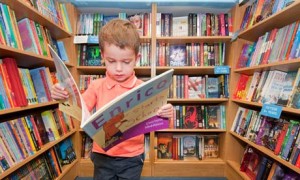Children’s reading shrinking due to apps, games and YouTube
View(s):Nielsen Book data suggests that 32% of children read books every day, and 60% every week. But these percentages are falling as digital entertainment rises
According to a survey of 2,000 British children and parents conducted by Nielsen Book in June this year, 50% of family households now own at least one tablet, up from 24% a year ago.
Is this a good thing for kids’ reading habits? Are they hoovering up e-books and delighting in digital book-apps on these devices? In a word: no. At least not according to data shared at The Bookseller Children’s Conference by research firm Nielsen Book.
The good news? 32% of children still read books for pleasure on a daily basis, the second most popular activity behind watching TV (36%), and well ahead of social networking (20%), watching videos on YouTube (17%) and playing mobile games and apps (16%).
On a weekly basis, 60% of children are reading books for pleasure, and if you factor in children who are being read to by parents, that percentage climbs to 72%. But…
“But there’s a really disturbing pattern beginning to emerge when you look on a weekly basis,” said Nielsen Book’s Jo Henry, presenting the findings to an audience of publishers.
Only three activities increased in percentage terms between 2012 and 2013: playing “game apps” (the term used by Nielsen Book), visiting YouTube and text messaging. Reading? That was down nearly eight percentage points.
“It’s a snapshot, not a sustainable trend and next year it might go up again. But this is alarming: children are being less engaged with reading,” said Henry, who also pointed to industry figures showing an 8% year-on-year drop in (printed) books bought for children.
“I want to stress that most children are still medium and heavy book readers, but what we’re seeing is a really significant rise in the number of occasional and even non-readers in the children’s market.”
Nielsen Book has specific definitions for those terms. Heavy readers are defined as children who read at least weekly, and for an average of 45 minutes or more a day. Medium are a little less than that, light are those reading weekly but for less than 15 minutes a day on average, and occasional readers are those who read 1-3 times a month.
“What we’re seeing is that non-readers have risen from 22% to 28% of all children,” said Henry, who went on to claim that it’s not just reading that is suffering from the growth in apps and YouTube use: activities including going out, hobbies and art are also being dropped.
“It’s hugely impacting on teenagers: 11-17 year-olds are actually dropping their participation in quite a broad range of activities in order to play game apps,” said Henry.
Nielsen’s data shows that among 11-17 year-olds, non-readers grew from 13% to 27% between 2012 and 2013, while occasional readers fell from 45% to 38%; light dropped from 4% to 2%; medium readers fell from 23% to 17%; and heavy readers grew from 15% to 16%.
Nielsen has also asked children whether they’d like to read digitally. In 2012, 21% said they were doing it already, while 38% said they’d like to. In 2013, those respective percentages were 33% and 28%.
“There is something around we’re not making it attractive enough to do it: there’s not much aspirational stuff there,” said Henry. “We all hoped the attraction of digital reading would bring lighter readers into the market. But they’re still less likely than the heavier-reading teenagers to be reading e-books and apps.”
All doom and gloom? Henry’s presentation was followed by a talk from Lynne Taylor and Simon Appleby of The Reading Agency about this summer’s Creepy House summer reading challenge, which ran in libraries across the UK, encouraging children to borrow, read and talk about books.
More than 750,000 children took part, with just over 48,000 of them signing up as new library members. 43% of the participants were boys – seen as a tougher group to reach for reading.
In a panel session following Henry’s talk, Dylan Collins from children’s discovery startup SuperAwesome said parents bear some of the responsibility for ensuring children don’t abandon reading in favour of games and social media.
“The challenge continues to be one of attention and maintaining attention. I often get asked by parents ‘shouldn’t you be doing more to make our children read or not look at the internet and TV so much?’ To which I say, yeah, I think that’s where the mother/father line starts to apply,” he said.
“Parenting does come into this, in terms of parents saying to their kids ‘you need to be reading, please start reading, or I’m going to take all your electronic devices away!’”
However, Collins said that some of the technologies and services seen as squeezing out reading could help bring children back to books, whether physical or digital. YouTube was the key example.
“If you can find a way to harness video to get kids talking about books, reviewing books, starting book clubs with video as a part of that, now would be the time to do it,” he said. Henry offered a final optimistic note. Well, partly. “There is no evidence that more kids thought reading was uncool in our survey,” she said. “Their opinions of reading as an activity hadn’t gone down. They were just doing less of it.”
-theguardian.com
comments powered by Disqus

